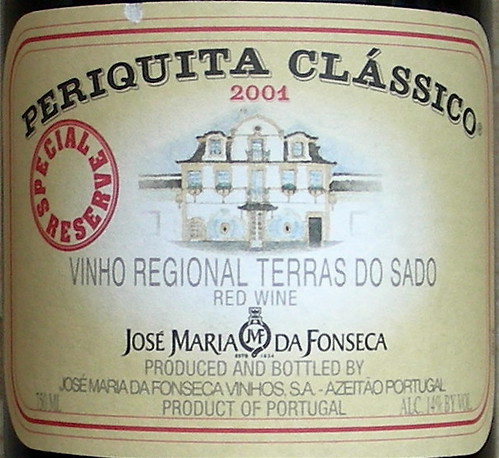Our last wine club tasting event was in September, kindly hosted by my sister in law. This was our first gathering after the long summer break and it was great to see everybody again. And this time, in order to prolong our summer vacation memories, I had decided to select a set of summer wines from different Mediterranean regions.
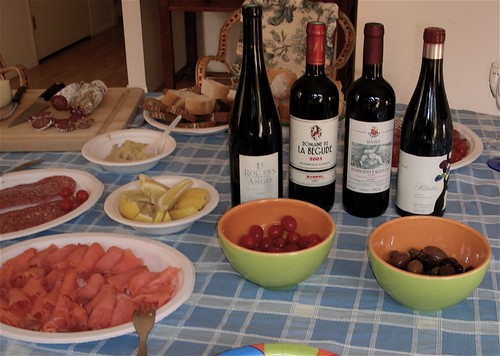
So that day, we tasted 7 different wines, two whites, one rosé, and four reds, from Greece, Spain, Sicily, Provence, and Roussillon. Here are my notes:

•
2006 Sigalas Santorini Assyrtiko.
Santorini is the southernmost and maybe the most beautiful member of the Cyclades islands in the Aegean Sea. It is a a volcanic island that suffered a devastating explosion around 1500 BC, leaving a huge, submerged caldera where the center of the Island had been. The island is covered with volcanic ash, lava and pumice stone, perfect soil conditions to grow vines. There is little rain during the year, except in winter. However, nocturnal moisture coming from the sea brings needed water to the vines. The dominant white grape is
Assyrtiko, often described as Greece's best white varietal. Growing on the arid, volcanic soils of Santorini, the varietal is known to produce very distinctive wines. My notes: Light yellow color, aromas of white flowers on the nose, fresh acidity on the palate. The perfect summer sipper.
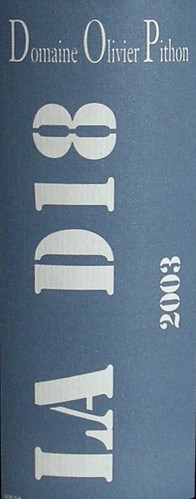
•
2003 Vin de Pays des Côtes Catalanes Blanc Domaine Olivier Pithon La D18:
Olivier Pithon has been involved in winemaking from an early age. His Grandfather was making wines in Anjou and his brother is one of the best Loire Valley producers. The D18 cuvée was named after a local breathtaking road that goes through the
Corbières mountains, west of Perpignan, and is based on a selection of the best slopes of White and Grey Grenache. My notes: yellow color, herbal nose, oxidized sherry flavors on the palate. Was the wine flawed?

•
2006 Côtes de Provence Rosé Château de Pampelonne: The wine comes from the ultra-trendy
Saint Tropez peninsula. It's a typical rosé of Provence, blending Mediteranean varieties such as Tibouren, Cinsault, Grenache, and Syrah. My notes: light salmon color and aromas of citrus and red berries. On the palate, dry and crisp, with a mineral finish. Very well crafted, perfect with a
Pissaladière or some
Petits Farcis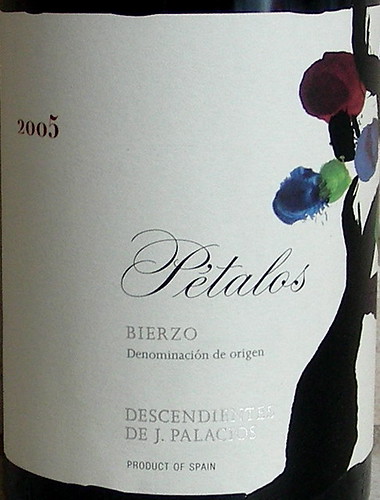
•
2005 Descendientes de Jose Palacios Petalos del Bierzo :
Bierzo is a small wine region in Northwestern Spain. The main variety is
Mencia, an indigenous grape that was thought to be related to Cabernet Franc. The wine is made by Alvaro Palacios, one of Priorat's leading producers, and his family. My notes: 100% Mencia, dark purple color, peppery nose with notes of violet, thick with tannins on the palate, ripe fruits flavors, long finish. A serious wine.
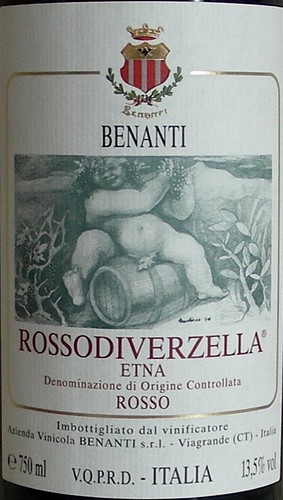
•
2002 Benanti Etna Rosso di Verzella: The wine comes from the volcanic, sun-drenched, arid slopes of
Mount Etna. It is a blend of Nerello Mascalese and Nerello Cappuccio, the two main indigenous grape varieties of the Etnean region. The
Azienda Vinicola Benanti is one of the best producers of the region and was recently awarded the
Winery of the Year title at a
Gambero Rosso event in San Francisco. My notes: medium red color, fragrant herbaceous aromas on the nose, fruity, slightly pruny, nice mineral finish. Extremely food friendly.
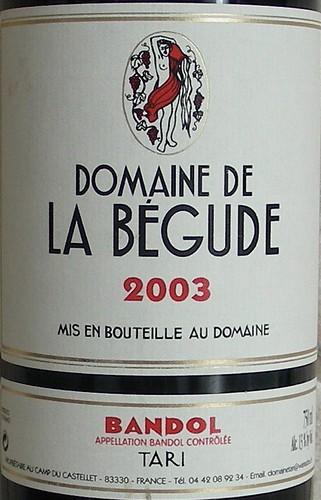
•
2003 Bandol Domaine de la Bégude: The wines of the
Bandol appellation are considered the best of Provence. One of the reason for their special typicity is the high amount of
Mourvèdre that has to be included in the blend (at least 50% for the appellation). The vineyard of the
Domaine de la Bégude is situated at the top of the appellation, 400 meters above the Mediterranean sea. The vines are cultivated on terraces facing south. Their red Bandol is a blend of 85% Mourvèdre and 15% Grenache. My notes: red ruby color, nose of black currant and caramel, elegant and balanced on the palate, aromatic finish. Classy!
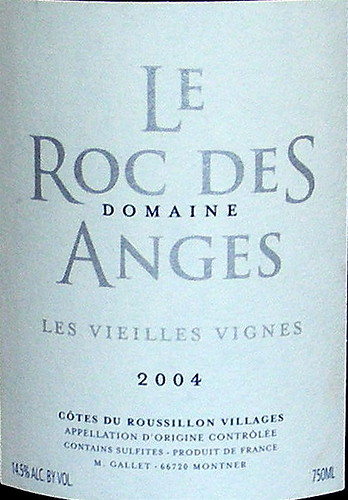
•
2004 Côtes du Roussillon Domaine Le Roc des Anges Vieilles Vignes: The Domaine des Anges is a 13 hectare estate located 30 kilometers northwest of Perpigan in the
Côtes du Roussillon appellation. The vineyard comprises old vines of Carignan, Grenache Gris, Grenache Noir, Syrah, and Maccabeu growing on decomposed flaky schists, which allow excellent drainage and encourage the vines to form deep root systems. The Vieilles Vignes cuvée is a blend of 40% Carignan, 40% Grenache Noir, and 20% Syrah with an average vine age of around 70 years old. My notes: dark color, nose of ripe black fruits, rich and full on the palate, almost chewy. Should be perfect with a beef stew.
Our next tasting event will feature a selection of wines from Argentina and Chile. These two countries are making better wines than ever and they are still very affordable, so stay tuned!
Previous wine club tastings:
•
Guess the wine tasting•
Tasting the wines of Australia and New Zealand•
Tasting the wines of PiedmontTechnorati tags: wine food & drink
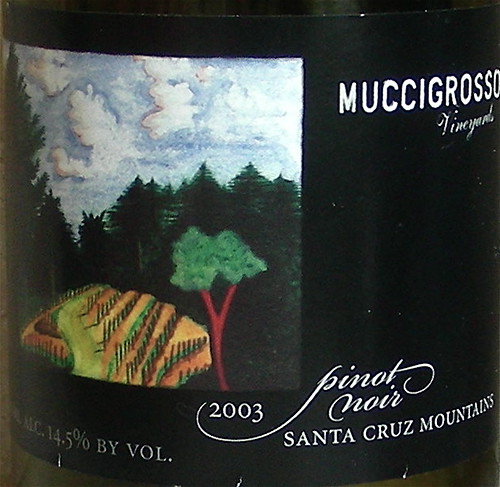 Forget the candies tonight, they're too sweet and not wine friendly at all. Have a glass of wine instead, for example, the 2003 Muccigrosso Pinot Noir from the Santa Cruz Mountains. This is one of my favorite Pinots. It is medium red in color with an attractive nose of sweet berry fruit. The palate is juicy, fruity and very well-balanced in terms of acidity and tannins. The finish is long and spicy. This is the kind of Pinot Noir that has more fruit and body than a Burgundy but is not as big, jammy, Syrah-like as so many California Pinots.
Forget the candies tonight, they're too sweet and not wine friendly at all. Have a glass of wine instead, for example, the 2003 Muccigrosso Pinot Noir from the Santa Cruz Mountains. This is one of my favorite Pinots. It is medium red in color with an attractive nose of sweet berry fruit. The palate is juicy, fruity and very well-balanced in terms of acidity and tannins. The finish is long and spicy. This is the kind of Pinot Noir that has more fruit and body than a Burgundy but is not as big, jammy, Syrah-like as so many California Pinots.









